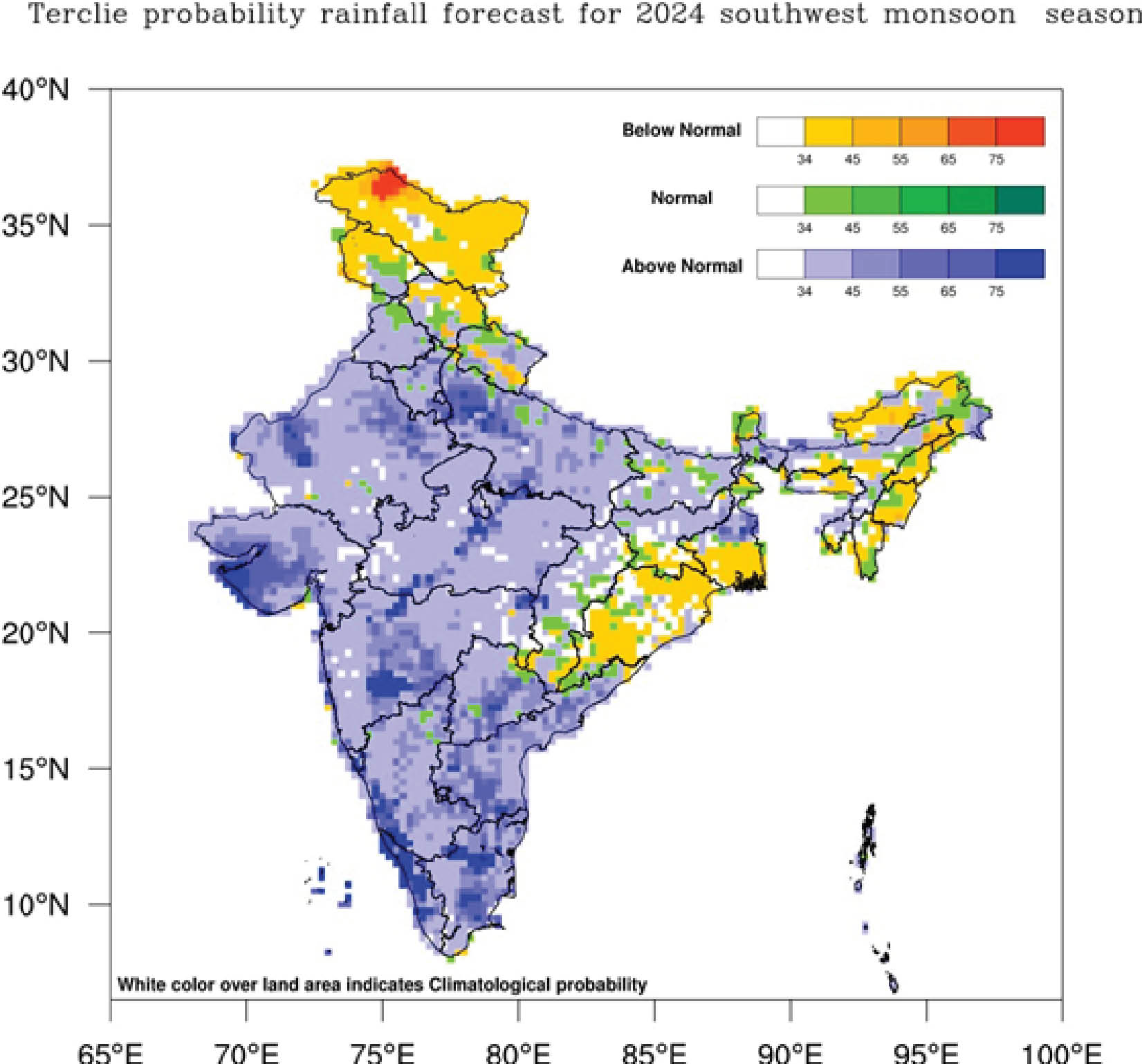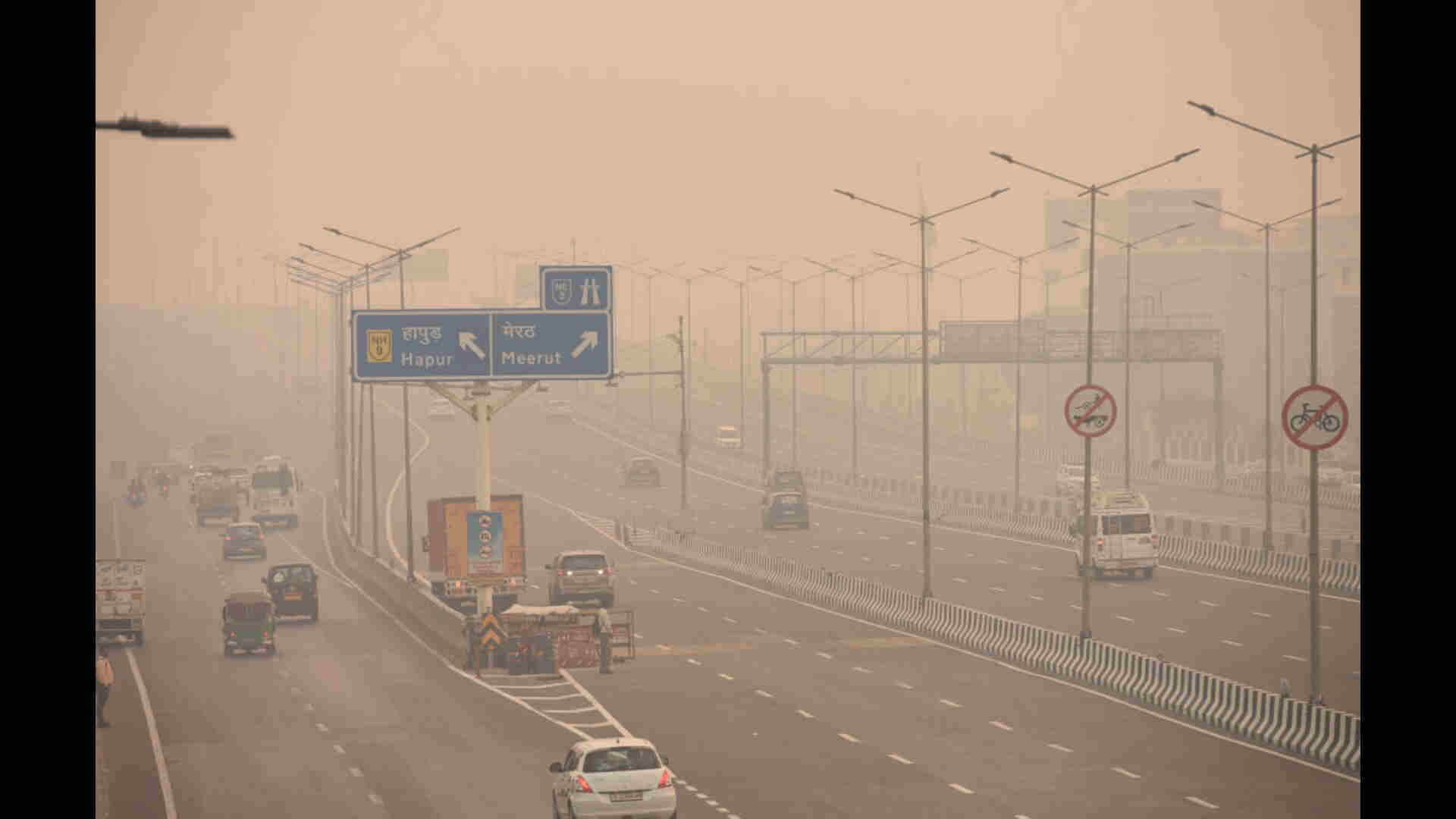Since 2021, the India Meteorological Department (IMD) has been using a new strategy for issuing operational long rangeforecasts on a monthly and seasonal scales for rainfall and temperatures across the country. For this, a newly developed Multi-Model Ensemble (MME) forecasting system is used. The MME system utilizes simulations from the coupled global climate models (CGCMs) sourced from various global climate prediction and research centers, including IMD’s Monsoon Mission Climate Forecasting System (MMCFS) model.
On 15th April, 2024, the IMD had issued the first-stage forecast for the 2024 southwest monsoon seasonal (June to September) rainfall, consisting of quantitative and probabilistic forecasts for the country as a whole, and the spatial distribution of probabilistic forecasts for the tercile categories (above normal, normal, and below normal) of the seasonal (June-September) rainfall.
As part of the second stage forecasts, the IMD has prepared the following forecasts:
1 Updated quantitative and probabilistic forecasts for the monsoon seasonal rainfall over the country as a whole and spatial distribution of the probabilistic forecasts for the seasonal rainfall over the country.
2. Probabilistic forecasts for the seasonal rainfall over the four homogenous regions of India (northwest India, central India, south Peninsula, and northeast India) and the monsoon core zone (MCZ) consisting of most of the rainfed agriculture areas of the country.
3. Probabilistic forecast for the June rainfall over the country as a whole and spatial distribution of the probabilistic forecasts for the June rainfall over the country.
4. Spatial distribution of the probabilistic forecasts for the June Temperatures (Maximum and Minimum) and Outlook for Heatwaves for the month of June over the country.
The updated MME forecast for the 2024 southwest monsoon season rainfall has been calculated by incorporating forecasts from different CGCMs based on the May initial conditions. The MME forecast specifically utilizes best few climate models that have the highest forecast skills over the Indian monsoon region, including the IMD’s MMCFS model to prepare an improved and reliable forecast.
Heat Wave over a location refers to a prolonged period of excessively hot weather (above certain threshold temperature value) over the location.
2. Sea Surface Temperature (SST) Conditions in the equatorial Pacific & Indian Oceans
The strong El Niño conditions over equatorial Pacific observed in early part of this year have weakened rapidly into weak El Niño conditions and are currently transitioning into ENSO-neutral conditions. The latest Climate model forecasts indicate ENSO-neutral conditons are likely to establish during the beginning of the monsoon season and La Niña conditions are likely to develop during the later part of the monsoon season.
At present, neutral Indian Ocean Dipole (IOD) conditions are prevailing over the Indian Ocean. The latest global climate model forecasts indicate these contions to transform into positive IOD conditions during the monsoon season.
3. Second Stage Forecasts for the 2024 Southwest Monsoon Rainfall
3a. Updated Forecast for the Rainfall over the Country as a whole during Monsoon Season, 2024
Quantitatively, the monsoon seasonal rainfall for the country as a whole is likely to be 106% of the Long Period Average (LPA) with a model error of ± 4%. The LPA of the season rainfall over the country as a whole for the period 1971-2020 is 87 cm.
The 5 category probability forecasts for the Seasonal (June to September) rainfall over the country as a whole during 2024 are given below. It suggests highest probability for the above normal rainfall (105-110% of LPA) for the country as a whole. It may be noted that the probability for above normal rainfall category is exactly double of its climatological probability.
3.b. Updated Forecast for the Spatial Distribution of rainfall over the Country during monsoon season, 2024
The spatial distribution of probabilistic forecasts for tercile categories (above normal, normal, and below normal) of seasonal rainfall (June to September, 2024) is depicted in Figure 1. The forecast indicates above normal rainfall is most likely over most parts of the country except many areas of northern part of Northwest India, Northeast India and eastern part of the Central India and adjoining areas of east India where below normal to normal rainfall is most likely.There is no signal by the model over the white shaded areas within the land region of the country.

Above-normal rainfall can boost agriculture and water resources but also brings risks of flooding, transportation disruptions, public health issues, and ecosystem damage. To manage these, it is advised to reinforce infrastructure, implement early warnings provided by IMD, enhance surveillance and conservation efforts, and build suitable response systems in sectors likely to be affected.
3c. Forecast for the Monsoon Rainfall over the four Homogenous regions of the country and Monsoon Core Zone (MCZ) during Monsoon Season, 2024
The tercile category forecasts for the four broad homogenous regions and MCZ for the monsoon seasonal (June-September) rainfall during 2024 are given in the tables below. Tercile categories have equal climatological probabilities of 33.33% of LPA each.
4. Probabilistic Forecast for the Rainfall over the Country during June, 2024
The average June rainfall for the country as a whole is most likely to be normal (92-108% of the Long Period Average (LPA)).The LPA of the June rainfall over the country as a whole for the period 1971-2020 is16.69cm.
The spatial distribution of probabilistic forecasts for tercile categories (above normal, normal, and below normal) for rainfall during June, 2024 is displayed in Figure
2. The above normal monthly rainfall is most likely over most areas of the south
peninsula, and adjoining central India, and over isolated areas of Northwest and Northeast India. Below normal rainfall is most likely over many areas of northern and eastern parts of Northwest India and eastern part of Central India, and some areas over Northeast India and southeastern Peninsula. Normal rainfall is most likely over the remaining areas.There is no signal by the model over white shaded areas within the land region of the country.
5. Probabilistic Forecast for the Temperatures over the Country during June, 2024
In June 2024, above-normal monthly maximum temperatures are likely over most parts of the country, except many parts of the southern peninsular India, where normal to below-normal temperatures are most likely.
During June 2024, above-normal monthly minimum temperatures are likely across most parts of the country, except for the extreme northern parts of northwest India and a few pockets of east and Northeast India, where normal to below-normal minimum temperatures are most likely(Fig. 3b).
6. Heat Wave outlook for the Month of June 2024
The anomaly (deviation from the normal) forecast for the number of heatwave days in the country for June 2024 is shown in Fig. 4. During June, 2024, above- normal heatwave days are likely over most parts of Northwest India and adjoining areas of Central India.
During heat waves, vulnerable populations, like the elderly and those with health conditions, face risks of heat-related illnesses. Prolonged extreme heat strains infrastructure and leads to dehydration.
Authorities must act proactively by opening cooling centers, issuing advisories, and reducing urban heat islands. These steps are crucial for protecting public health during heat waves. One has to stay hydrated and remain under optimally cool environment and avoid strenuous activities during peak heat hours to stay safe during heatwaves.
7. Extended Range Forecast and short to medium range forecasting services
IMD also regularly prepares and provides extended range forecasts (7–day averaged forecasts for the next four weeks) for rainfall, maximum temperatures, and minimum temperatures over the country. These forecasts are updated every week on Thursday.
These forecasts are based on the Multi-model Ensemble Dynamical Extended Range Forecasting System, which is currently operational at IMD. The forecasts are available through the IMD website
https://mausam.imd.gov.in/imd_latest/contents/extendedrangeforecast.php).
The extended range forecast is followed by short to medium range forecasts issued daily based on various very high resolution Global abd Regional Models.























